The canine cancer screening services market is projected to increase from USD 435.5 million in 2025 to USD 817.5 million by 2035, reflecting an absolute gain of USD 382.0 million over the forecast period at a CAGR of 6.5%. Between 2025 and 2030, the market is expected to grow from USD 435.5 million to USD 596.7 million, accounting for 43% of the decade’s incremental expansion. Growth during this stage is driven by greater veterinary adoption of cancer screening protocols and increasing reliance on cut biopsy procedures as the primary diagnostic method. Cut biopsy services hold the dominant share at 56% due to their established diagnostic reliability and suitability for definitive cancer characterization.
From 2030 to 2035, the market is expected to rise from USD 596.7 million to USD 817.5 million, contributing 57% of total growth. This phase is expected to see increased transition toward liquid biopsy and molecular screening, which enable earlier detection and lower procedural burden. Pet hospitals represent about 60% of market utilization due to their diagnostic equipment access and oncology consultation capacity. Regional expansion will be led by East Asia, South Asia Pacific, and Western Europe as veterinary infrastructure and preventive care adoption continue to grow.
Quick Stats for Canine Cancer Screening Services Market
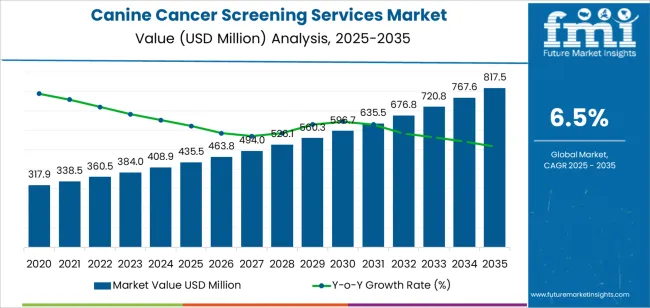
The latter half (2030-2035) will see continued growth from USD 596.7 million to USD 817.5 million, adding USD 220.8 million, or 57% of the decade's expansion. This period will be defined by mass market penetration of liquid biopsy technologies, integration with comprehensive veterinary health management platforms, and seamless compatibility with existing diagnostic infrastructure. The market trajectory signals fundamental shifts in how veterinary facilities approach cancer detection and preventive care management, with participants positioned to benefit from growing demand across multiple biopsy types and clinical settings.
Where revenue comes from - now vs next (industry-level view)
| Period | Primary Revenue Buckets | Share | Notes |
|---|---|---|---|
| Today | Biopsy services (cut, needle, liquid) | 48% | Procedure-driven, diagnostic testing |
| Laboratory analysis & pathology | 24% | Histopathology, cytology services | |
| Sample collection & handling | 14% | Specimen preparation, logistics | |
| Consultation & interpretation | 10% | Veterinary oncology expertise | |
| Screening packages & wellness | 4% | Preventive screening programs | |
| Future (3-5 yrs) | Molecular screening services | 38-42% | Liquid biopsy, circulating tumor DNA |
| Comprehensive screening panels | 20-25% | Multi-cancer detection, risk assessment | |
| Subscription screening programs | 15-18% | Annual screening, wellness monitoring | |
| Digital pathology services | 10-12% | Remote diagnosis, AI-assisted analysis | |
| Genetic testing integration | 8-10% | Breed-specific risk, hereditary markers | |
| Data services (outcome tracking, treatment response) | 5-7% | Predictive analytics for veterinarians |
At-a-Glance Metrics
| Metric | Value |
|---|---|
| Market Value (2025) | USD 435.5 million |
| Market Forecast (2035) | USD 817.5 million |
| Growth Rate | 6.5% CAGR |
| Leading Technology | Cut Biopsy Services |
| Primary Application | Pet Hospital Segment |
The market demonstrates strong fundamentals with cut biopsy services capturing a dominant share through established diagnostic reliability and comprehensive tissue analysis for diverse cancer detection. Pet hospital applications drive primary demand, supported by increasing pet cancer diagnoses and advanced veterinary care requirements. Geographic expansion remains concentrated in developed markets with established veterinary infrastructure, while emerging economies show accelerating adoption rates driven by pet healthcare modernization and rising diagnostic standards.
Primary Classification: The market segments by biopsy type into Cut Biopsy and Needle Biopsy services, representing the evolution from traditional tissue sampling to advanced diagnostic procedures for comprehensive cancer detection and characterization.
Secondary Classification: Application segmentation divides the market into Pet Hospital and Clinic sectors, reflecting distinct requirements for case volume, diagnostic capabilities, and facility service offerings.
Regional Classification: Geographic distribution covers major markets including China, India, Germany, Brazil, United States, United Kingdom, and Japan, with developed markets leading adoption while emerging economies show accelerating growth patterns driven by veterinary care expansion programs.
The segmentation structure reveals technology progression from standard biopsy procedures toward sophisticated molecular screening services with enhanced sensitivity and diagnostic precision, while application diversity spans from specialty pet hospitals to general veterinary clinics requiring reliable cancer detection solutions.
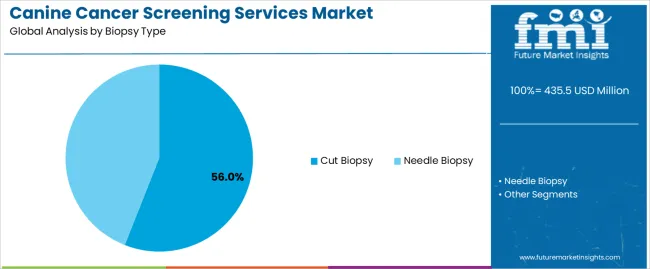
Market Position: Cut Biopsy services command the leading position in the canine cancer screening services market with 56% market share through comprehensive tissue analysis, including superior diagnostic accuracy, detailed histopathological examination, and cancer characterization capabilities that enable veterinary pathologists to achieve optimal diagnostic precision across diverse cancer types and clinical presentations.
Value Drivers: The segment benefits from veterinary preference for reliable diagnostic methods that provide complete tissue architecture, definitive cancer diagnosis, and comprehensive pathological information without compromising diagnostic quality. Advanced processing techniques enable detailed cellular analysis, tumor grading capabilities, and integration with standard pathology workflows, where diagnostic certainty and treatment planning support represent critical clinical requirements.
Competitive Advantages: Cut Biopsy services differentiate through proven diagnostic reliability, comprehensive tissue evaluation, and compatibility with established veterinary pathology protocols that enhance clinical decision-making while maintaining optimal diagnostic accuracy suitable for diverse cancer screening applications.
Key market characteristics:
Needle Biopsy services maintain a 44% market position in the canine cancer screening services market due to minimally invasive sampling advantages and rapid diagnostic capabilities. These services appeal to veterinary facilities requiring less invasive procedures with reduced anesthesia requirements for preliminary cancer assessment. Market growth is driven by preventive screening expansion, emphasizing accessible diagnostic solutions and procedural efficiency through optimized sampling techniques.

Market Context: Pet Hospital applications demonstrate the highest growth rate in the canine cancer screening services market, holding 60% share due to widespread adoption of advanced diagnostic services and increasing focus on comprehensive veterinary oncology, diagnostic infrastructure optimization, and specialized care capabilities that maximize cancer detection while maintaining clinical standards.
Appeal Factors: Pet hospital facilities prioritize diagnostic accuracy, comprehensive screening capabilities, and integration with existing veterinary infrastructure that enables coordinated oncology services across multiple specialties. The segment benefits from substantial pet healthcare investment and facility modernization programs that emphasize the acquisition of advanced screening services for diagnostic optimization and cancer care applications.
Growth Drivers: Pet hospital expansion programs incorporate cancer screening services as standard offerings for preventive care operations, while specialty veterinary medicine growth increases demand for comprehensive diagnostic capabilities that comply with oncology standards and support treatment planning.
Market Challenges: Varying case complexity and client affordability may limit service standardization across different facilities or patient populations.
Application dynamics include:
Clinic applications capture 40% of the market share through primary care screening in general veterinary practices, wellness clinics, and community animal hospitals. These facilities demand accessible screening services capable of supporting routine preventive care while providing effective cancer detection and referral capabilities.
| Category | Factor | Impact | Why It Matters |
|---|---|---|---|
| Driver | Rising pet cancer incidence (aging pet population, breed predisposition) | ★★★★★ | Increased cancer diagnoses drive screening demand; demographic trends support sustained growth in diagnostic services. |
| Driver | Pet humanization & willingness to invest in healthcare | ★★★★★ | Pet owners treating animals as family members; willing to pay for preventive care and early detection services. |
| Driver | Veterinary oncology advancement & treatment options | ★★★★☆ | Better treatment outcomes justify screening investment; early detection improves prognosis and survival rates. |
| Restraint | High screening costs & pet insurance limitations | ★★★★☆ | Limited insurance coverage for preventive screening; cost barriers restrict widespread adoption in price-sensitive markets. |
| Restraint | Limited awareness & veterinary recommendation gaps | ★★★☆☆ | Pet owners unaware of screening benefits; requires veterinary education and proactive recommendation protocols. |
| Trend | Liquid biopsy & molecular screening technologies | ★★★★★ | Non-invasive blood-based screening enables easier testing; early cancer detection before clinical symptoms appear. |
| Trend | Breed-specific screening protocols & genetic testing | ★★★★☆ | Targeted screening for high-risk breeds; personalized prevention strategies based on genetic predisposition. |
The canine cancer screening services market demonstrates varied regional dynamics with Growth Leaders including China (8.8% growth rate) and India (8.1% growth rate) driving expansion through pet healthcare modernization initiatives and veterinary service development. Steady Performers encompass Germany (7.5% growth rate), United States (6.2% growth rate), and developed regions, benefiting from established pet care industries and advanced veterinary diagnostic adoption. Emerging Markets feature Brazil (6.8% growth rate) and developing regions, where pet ownership growth and veterinary care modernization support consistent expansion patterns.
Regional synthesis reveals East Asian markets leading adoption through pet population growth and veterinary infrastructure development, while Western European countries maintain strong expansion supported by comprehensive pet healthcare systems and preventive care integration. North American markets show steady growth driven by specialty veterinary services and pet insurance expansion.
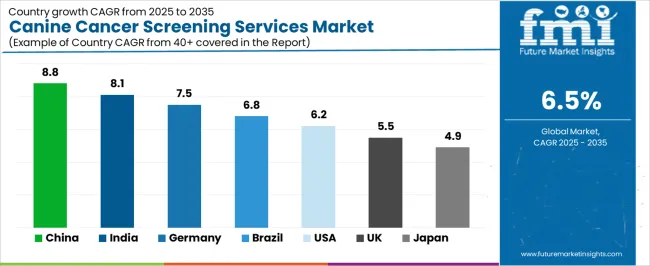
| Region/Country | 2025-2035 Growth | How to win | What to watch out |
|---|---|---|---|
| China | 8.8% | Lead with accessible screening packages | Regulatory evolution; affordability barriers |
| India | 8.1% | Focus on education and veterinary partnerships | Infrastructure limitations; awareness gaps |
| Germany | 7.5% | Offer comprehensive diagnostic services | Conservative adoption; cost sensitivity |
| Brazil | 6.8% | Provide value-oriented screening options | Economic volatility; veterinary network density |
| United States | 6.2% | Push molecular screening and innovation | Market saturation; insurance coverage gaps |
| United Kingdom | 5.5% | Integrate with preventive care programs | Veterinary consolidation; price competition |
| Japan | 4.9% | Emphasize quality and diagnostic accuracy | Aging pet population; veterinary capacity |

China establishes fastest market growth through aggressive pet healthcare development programs and comprehensive veterinary service expansion, integrating advanced cancer screening services as standard offerings in urban pet hospitals and specialty veterinary centers. The country's 8.8% growth rate reflects rising pet ownership and increasing willingness to invest in pet healthcare that supports adoption of diagnostic services in major cities. Growth concentrates in tier-one and tier-two cities, including Beijing, Shanghai, and Shenzhen, where pet healthcare infrastructure showcases modern veterinary facilities that appeal to pet owners seeking advanced diagnostic capabilities and preventive care applications.
Chinese veterinary service providers are developing accessible screening programs that combine local market understanding with international diagnostic standards, including laboratory partnerships and quality assurance protocols. Distribution channels through pet hospital networks and veterinary clinic chains expand service access, while growing pet humanization trends support adoption across diverse pet owner segments.
Strategic Market Indicators:
In Mumbai, Delhi, and Bangalore, pet hospitals and specialty veterinary clinics are implementing cancer screening services as advanced diagnostic offerings for preventive care and oncology support applications, driven by increasing urban pet ownership and veterinary care modernization programs that emphasize diagnostic capabilities. The market holds an 8.1% growth rate, supported by growing middle-class pet ownership and rising awareness of veterinary healthcare benefits that promote screening service adoption. Indian pet owners are seeking comprehensive veterinary care that provides advanced diagnostic options and preventive health management, particularly appealing in urban regions where pet healthcare quality represents important ownership considerations.
Market expansion benefits from veterinary education advancement and international diagnostic technology access that enables screening service implementation in well-equipped facilities. Technology adoption follows patterns established in human healthcare diagnostics, where early detection benefits and treatment outcome improvements drive service utilization and client acceptance.
Market Intelligence Brief:
Germany's advanced veterinary care market demonstrates sophisticated cancer screening service deployment with documented diagnostic effectiveness in university veterinary hospitals and specialty animal clinics through integration with existing veterinary oncology programs and pathology services. The country leverages veterinary medicine expertise and diagnostic infrastructure to maintain a 7.5% growth rate. Veterinary centers, including university animal hospitals and specialty oncology practices, showcase comprehensive screening programs where services integrate with preventive care protocols and treatment planning systems to optimize cancer detection and patient outcomes.
German veterinary facilities prioritize diagnostic accuracy and evidence-based protocols in screening service implementation, creating demand for validated screening methods with proven sensitivity and specificity. The market benefits from established veterinary healthcare infrastructure and pet owner willingness to invest in preventive care that provides long-term health benefits and early intervention opportunities.
Market Intelligence Brief:
Brazil's market expansion benefits from diverse pet ownership growth, including veterinary service modernization in São Paulo and Rio de Janeiro, pet hospital development, and expanding middle-class pet ownership that increasingly incorporates preventive care services for health management applications. The country maintains a 6.8% growth rate, driven by rising pet population and increasing recognition of veterinary preventive care benefits, including early cancer detection and treatment success improvement.
Market dynamics focus on accessible screening services that balance diagnostic quality with affordability considerations important to Brazilian pet owners. Growing pet healthcare awareness creates continued demand for screening programs in established veterinary facilities and expanding clinic networks.
Strategic Market Considerations:
United States establishes market leadership through comprehensive veterinary oncology infrastructure and advanced diagnostic service capabilities, integrating cancer screening services across specialty pet hospitals and general veterinary practices. The country's 6.2% growth rate reflects mature veterinary industry relationships and established preventive care culture that supports widespread screening service availability in diverse clinical settings. Growth concentrates in major metropolitan areas and specialty veterinary networks, where healthcare facilities showcase comprehensive oncology services that appeal to pet owners seeking advanced diagnostic capabilities and early detection programs.
American veterinary practices leverage established diagnostic laboratory networks and specialty referral systems, including oncology consultation services and treatment coordination that create integrated cancer care delivery. The market benefits from pet insurance expansion and client willingness to invest in preventive healthcare that supports early intervention and treatment outcome optimization.
Market Intelligence Brief:
United Kingdom's veterinary care market demonstrates consistent cancer screening service adoption with integration in first-opinion veterinary practices and referral specialty hospitals through compatibility with preventive care protocols and oncology referral pathways. The country maintains a 5.5% growth rate through established veterinary healthcare delivery and client acceptance of preventive services. Major veterinary centers, including referral hospitals and corporate practice networks, showcase screening service offerings where diagnostic capabilities support comprehensive pet healthcare and early cancer detection.
British veterinary practices balance service accessibility with cost considerations in screening program development, influenced by competitive market dynamics and client price sensitivity. The market benefits from strong veterinary professional standards and clinical evidence requirements that drive adoption of validated screening services.
Market Intelligence Brief:
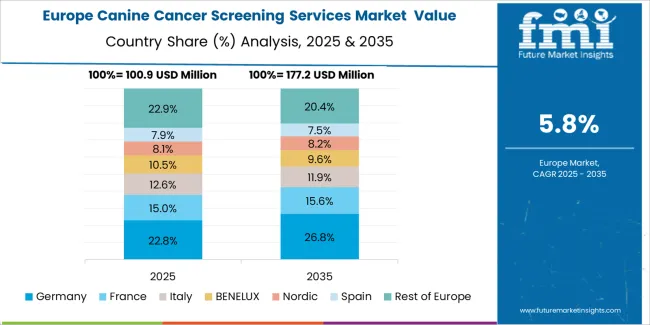
The canine cancer screening services market in Europe is projected to grow from USD 162.1 million in 2025 to USD 304.2 million by 2035, registering a CAGR of 6.5% over the forecast period. Germany is expected to maintain its leadership position with a 29.4% market share in 2025, supported by its advanced veterinary infrastructure and strong specialty oncology services.
United Kingdom follows with a 26.8% share in 2025, driven by comprehensive veterinary practice networks and established preventive care culture. France holds a 19.2% share through specialty veterinary hospitals and pet healthcare development. Italy commands a 13.6% share, while Spain accounts for 8.4% in 2025. The Rest of Europe region is anticipated to gain momentum, expanding its collective share from 2.6% to 3.8% by 2035, attributed to increasing screening service adoption in Nordic countries and emerging Eastern European veterinary practices implementing oncology diagnostic programs.
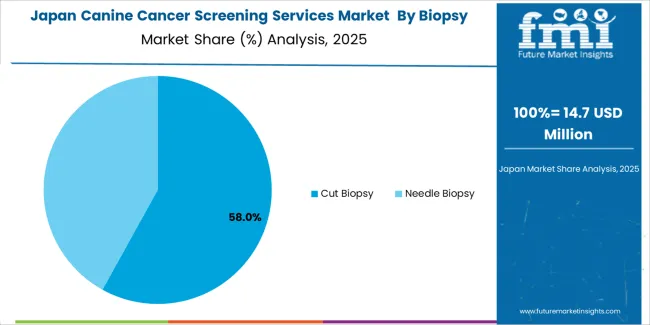
Japan's canine cancer screening services market reflects established pet healthcare infrastructure with sophisticated diagnostic service deployment across urban veterinary hospitals and specialty animal clinics. The country maintains a 4.9% growth rate, supported by high pet ownership rates and comprehensive veterinary care culture that sustains diagnostic service utilization. Japanese pet owners emphasize preventive healthcare and quality veterinary services, with preference for established diagnostic providers offering validated screening accuracy and comprehensive result interpretation.
Market dynamics focus on senior pet screening programs and breed-specific protocols, with steady demand growth constrained by aging pet population demographics and veterinary capacity limitations. Professional veterinary standards and clinical protocol adherence influence service delivery, while pet insurance coverage supports screening service accessibility. Distribution networks through established veterinary hospitals and diagnostic laboratory services maintain market structure, with opportunities concentrated in molecular screening technology adoption and comprehensive wellness program integration.
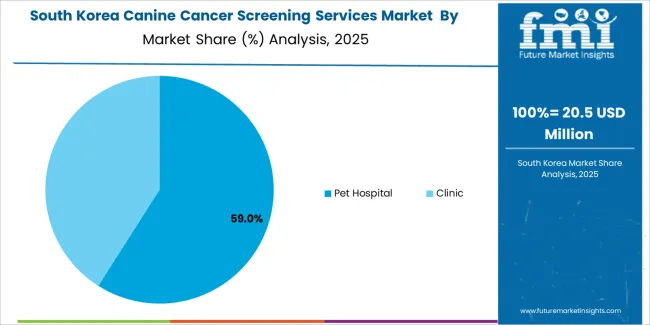
South Korea's pet healthcare market demonstrates active cancer screening service adoption with rapid integration of advanced diagnostic capabilities in metropolitan pet hospitals and specialty veterinary centers. The market exhibits 7.3% growth driven by rising pet ownership, increasing pet healthcare spending, and strong emphasis on preventive care services. Seoul, Busan, and other major cities showcase modern veterinary facilities where screening services represent important diagnostic offerings, supported by client education programs and veterinary oncology expertise.
Korean pet owners prioritize comprehensive healthcare for companion animals, driving demand for advanced screening services with molecular diagnostic capabilities and early detection benefits. Market expansion benefits from veterinary education advancement and international diagnostic technology partnerships, with veterinary professionals actively implementing latest screening protocols. Distribution channels combine specialty veterinary hospitals with diagnostic laboratory services, while pet insurance expansion and wellness program development facilitate screening service adoption and utilization across diverse pet owner segments.
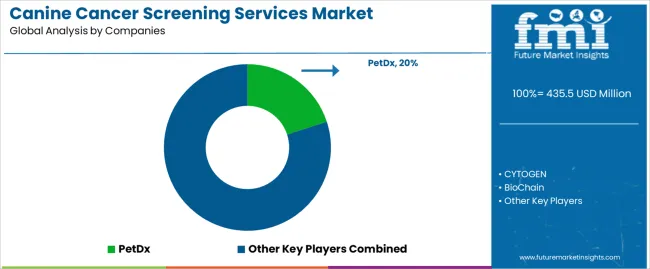
The competitive structure features 10-12 specialized players with the top 5 service providers holding approximately 58% market share by revenue. Leadership is maintained through proprietary screening technology, comprehensive veterinary networks, and continuous innovation focused on early detection accuracy and molecular diagnostic advancement. Market dynamics reflect emerging competition with veterinary diagnostic companies entering cancer screening while established laboratories expand oncology testing portfolios.
Basic histopathology services and standard biopsy processing are commoditizing, while margin opportunities exist in liquid biopsy technology, comprehensive screening panels, and integrated veterinary oncology support programs. Successful providers differentiate through clinical validation studies, veterinary education initiatives, and technical support that builds practitioner confidence and client acceptance. Market entry barriers include veterinary relationship development, regulatory compliance requirements, and clinical evidence generation across diverse cancer types.
Competition intensifies around molecular screening technologies for early detection, breed-specific screening protocols addressing genetic predisposition, and subscription-based wellness programs that integrate cancer screening with preventive care. Service providers increasingly offer comprehensive diagnostic solutions combining screening tests, veterinary consultation services, and treatment coordination to capture larger share of pet healthcare spending while ensuring diagnostic quality and clinical outcome optimization. Partnership models with veterinary practice management platforms and pet insurance companies gain traction as distribution strategies.
| Stakeholder | What they actually control | Typical strengths | Typical blind spots |
|---|---|---|---|
| Specialty diagnostic providers | Proprietary technology, laboratory networks, veterinary relationships | Advanced screening capabilities, clinical validation, technical expertise | Geographic service coverage; price accessibility |
| Veterinary hospital networks | Client relationships, service delivery, integrated care | Direct pet owner access, comprehensive care, trusted recommendations | Technology development; diagnostic innovation |
| Laboratory service companies | Processing capacity, pathology expertise, quality systems | Established diagnostics, reliable results, scalability | Veterinary-specific protocols; client education |
| Technology innovators | Molecular platforms, liquid biopsy, AI analysis | Latest detection methods, early diagnosis capability, research partnerships | Veterinary network density; clinical adoption |
| Regional veterinary groups | Local market knowledge, community relationships, practice integration | Client proximity, personalized service, affordable pricing | Technology access; standardization challenges |
| Item | Value |
|---|---|
| Quantitative Units | USD 435.5 million |
| Biopsy Type | Cut Biopsy, Needle Biopsy |
| Application | Pet Hospital, Clinic |
| Regions Covered | East Asia, South Asia Pacific, Western Europe, North America, Latin America, Eastern Europe, Middle East & Africa |
| Countries Covered | China, India, Germany, Brazil, United States, United Kingdom, Japan, South Korea, France, Italy, Spain, Canada, Australia, and 18+ additional countries |
| Key Companies Profiled | PetDx, CYTOGEN, BioChain, Small Door, ANGLE, BioChain Institute Inc., CANCAN DIAGNOSTICS |
| Additional Attributes | Dollar sales by biopsy type and application categories, regional adoption trends across East Asia, South Asia Pacific, and Western Europe, competitive landscape with veterinary diagnostic providers and specialty oncology services, veterinarian preferences for diagnostic accuracy and result turnaround time, integration with veterinary practice management and electronic health records, innovations in liquid biopsy technology and molecular screening, and development of breed-specific screening protocols with enhanced early detection and cancer characterization capabilities. |
The global canine cancer screening services market is estimated to be valued at USD 435.5 million in 2025.
The market size for the canine cancer screening services market is projected to reach USD 817.5 million by 2035.
The canine cancer screening services market is expected to grow at a 6.5% CAGR between 2025 and 2035.
The key product types in canine cancer screening services market are cut biopsy and needle biopsy.
In terms of application, pet hospital segment to command 60.0% share in the canine cancer screening services market in 2025.






Full Research Suite comprises of:
Market outlook & trends analysis
Interviews & case studies
Strategic recommendations
Vendor profiles & capabilities analysis
5-year forecasts
8 regions and 60+ country-level data splits
Market segment data splits
12 months of continuous data updates
DELIVERED AS:
PDF EXCEL ONLINE
Canine Arthritis Treatment Market Forecast and Outlook 2025 to 2035
Canine Orthopedic Implants Market Size and Share Forecast Outlook 2025 to 2035
Canine Dilated Cardiomyopathy Drugs Market – Trends & Forecast 2025 to 2035
The Canine Flu Therapeutics Market is segmented by product, and end user from 2025 to 2035
Canine Atopic Dermatitis Treatment Market Growth – Demand & Forecast 2024-2034
Canine Weight Loss Drugs Market
Global Canine Cancer Screening Market Analysis – Size, Share & Forecast 2024-2034
Cancer Registry Software Market Size and Share Forecast Outlook 2025 to 2035
Cancer Biological Therapy Market Size and Share Forecast Outlook 2025 to 2035
Cancer Diagnostics Market Analysis - Size, Share and Forecast 2025 to 2035
Cancer Biopsy Market - Growth & Technological Innovations 2025 to 2035
Cancer Vaccines Market Analysis by Technology, Treatment Method, Application and Region from 2025 to 2035
Cancer Gene Therapy Market Overview – Trends & Future Outlook 2024-2034
Cancer-focused Genetic Testing Service Market Analysis – Growth & Industry Insights 2024-2034
Cancer Tissue Diagnostic Market Trends – Growth & Industry Forecast 2024-2034
Cancer Supportive Care Products Market Trends – Growth & Forecast 2020-2030
Cancer Antigens Market
Pet Cancer Therapeutics Market Insights - Growth & Forecast 2024 to 2034
Skin Cancer Detection Devices Market Size and Share Forecast Outlook 2025 to 2035
Lung Cancer Diagnostics Market Size and Share Forecast Outlook 2025 to 2035

Thank you!
You will receive an email from our Business Development Manager. Please be sure to check your SPAM/JUNK folder too.
Chat With
MaRIA